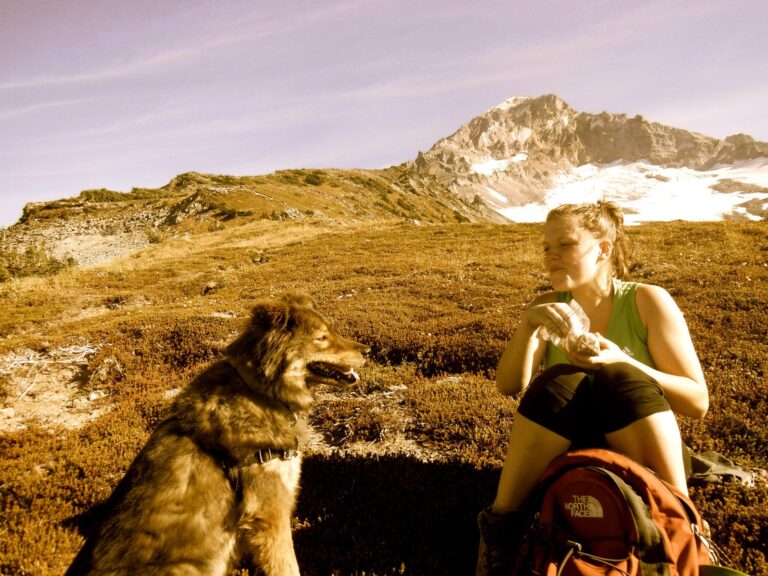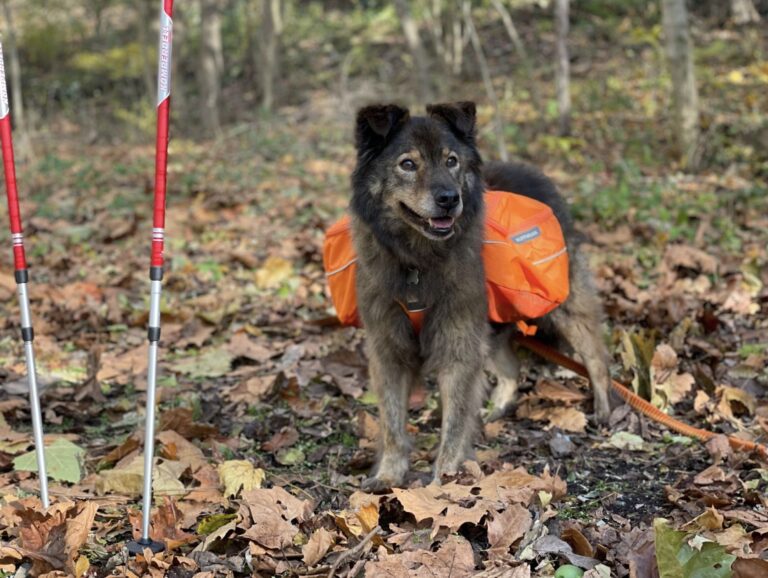A month after I adopted Reuben, a chow/Aussie mix, we packed up the car and drove out to Mt. Hood National Forest for his first long hike.
We had been doing long walks, short hikes, and runs, all in an attempt to redirect his energy and anxiety, and it felt like no matter how many miles we walked, he wanted more. So we headed out to McNeil Point, an 8.5-mile lollipop trail that took us straight up to a wide, grassy expanse above the treeline.
Up until that hike, all our outdoor adventures had had a manic undercurrent: me, trying to teach loose-leash skills and how to ignore other dogs while we walked and ran; and Reuben, a dog on his third home in five years, who had more energy than he knew what to do with, trying his hardest to heel, slow down and trust that he wasn’t going to be left by his family yet again.
This time, however, was different. After the initial excitement of zipping from side to side, smelling every bush and tree he could for the first mile, Reuben relaxed. He slowed down, no longer pulling at his lead but instead taking his time, sniffing as he pleased and looking back at me, nosing my hand or my knee to check in. When we reached the pinnacle of the trail, I sat down on the grass, feeling the sun on my sweaty shoulders, fully expecting Reuben to sniff around and ultimately sit as far from me as his lead would allow.
Instead, he circled a few times and plopped down right next to me. It was a breakthrough moment for us, and we continued to build trust and strengthen our relationship with every hike and camping trip over the years.
Exploring the great outdoors with your pup is a great way to exercise and introduce novelty and adventure into your routine—all the things that help dogs live happy lives and deepen the bond between you. So, if you’re interested in taking your dog hiking, here’s how to get out onto the trail.
The benefits of hiking with your dog
The physical, mental, and social benefits of exercising for dogs are well-documented—even a 30-minute walk aids weight management, promotes healthy joints, and gives dogs the mental stimulation that can help prevent destructive behaviors. For the right dog, hiking takes those benefits and turns them up to 11.
With varied, ever-changing terrain to navigate and endless new smells to process, hiking is a highly stimulating experience that combines the benefits of intense physical exercise and mental enrichment tasks.

Reuben blending in at McNeil Point
What to know before you go
Before you pick a trail and head out with your dog, be sure you’re both informed, and prepared.
Not every trail is dog-friendly
Not all hiking trails allow dogs—many national parks, for example, either ban dogs or only allow them in certain areas and on specific trails.
Dogs are typically banned to protect sensitive wildlife habitats, so it’s essential to honor these rules. If you’re caught in a no-dog zone with your dog, you could be looking at fines starting at $75.
To avoid dog-free trails, check the rules before you head out. The rules and regulations for most trails are available online; if they’re not, make a quick call to the body that maintains the trail you’re interested in, whether a state or national park or a private conservation group, and ask one of the rangers or volunteers.
Make yourself aware of the wildlife you and your pup may encounter on the trail and learn how to avoid confrontations. For hiking in bear country, for example, some experts recommend dogs wear bear bells (though others say a loud human voice is a better warning system—ask your local ranger if you’re unsure).
Not every dog is trail-friendly
While hiking has many benefits, they don’t apply to all dogs. For some types and sizes of dog, hiking may not be the most enjoyable activity, and, in fact, may be dangerous.
Brachycephalic dog breeds like French bulldogs, boxers, pugs, Pekingese, and Boston terriers, have a harder time regulating their breath and controlling their body temperature. They can be prone to overheating and exhaustion and may be better off with a less intense pastime.
Smaller dogs with short legs (looking at you, dachshunds) may find it hard to keep up on longer hikes, so keep them to flatter, easier, shorter hikes, or skip this activity altogether. On the other hand, extra-large dogs prone to joint problems may also struggle with long, challenging hikes.
Certain hounds and other dogs with high prey drives, who may have trouble listening when they pick up the scent or sight of an animal, should have bulletproof recall skills before hitting the trail.
And mind the age of your hiking companion. Puppies are not good candidates for hiking; the strenuous activity can damage their growth plates, and their immune systems are not fully developed, so they can get very sick from the various pathogens that are common in the woods. And older dogs with mobility issues shouldn’t hit the trails.
Trail etiquette for your pup
General etiquette includes staying on the trail, picking up after yourself, giving uphill hikers the right of way, and hiking in single file when passing other hikers. For dogs, the National Parks System has a dog-specific etiquette system called BARK that all hikers should follow:
- Bag your pet’s waste: some hikers either leave their dog’s waste or bag it and leave it on the trail to pick it up later. Both of these are huge no-nos, because dog waste contains harmful bacteria and other pathogens that can negatively impact the wildlife.
- Always leash your pet: Your dog should also always be within six feet of you. Although some people let their dogs off-leash, this can create dangerous conditions, especially if they have poor recall skills. Remember: you may love your dog, and they may be friendly, but not everyone loves dogs, and not all dogs they encounter are friendly. Unleashed dogs can attack or be attacked by wildlife or other dogs, fall from steep edges, and even injure other hikers. The best way to protect everyone from injuries or other unfortunate incidents is to keep them leashed.
- Respect wildlife: When hiking, we’re interlopers. To minimize disturbing the wildlife, don’t let your dog chase the creatures you encounter.
- Know where you can go: Trails are there for a reason. Except in emergency situations, don’t bushwhack (go off-trail). This will minimize flora and fauna disturbances and the possibility of getting lost or injured without a clear way to find help.
Hiking gear guide
Another facet of preparedness is making sure you have all the gear necessary for a safe and enjoyable hike, whether it’s a quick 4-mile loop with only 500 feet of elevation gain or a 12-mile out-and-back with a punishing 2,000 foot ascent. Here’s what you should always have on hand:
First aid kit: Injuries happen, even to the most experienced hikers, whether on two feet or four. For dogs, that usually means paw injuries or bites. Be sure to bring either a lightweight canine medical kit, or carry a towel (microfiber is a lightweight option), hydrogen peroxide, antibiotic ointment or spray, gauze (or another similar wrapping bandage), a tick remover or tweezers, a soft muzzle, and Benadryl in case of an allergic reaction or bee sting (both can be common when hiking and can be dangerous with no remedy close by).
Food and water: Always bring sufficient food and water (and a collapsible water bowl). Depending on how strenuous your hike is, your dog will require upwards of 25% more calories than their typical intake. They’ll also need more water than usual. Be sure to bring ample water and pause to hydrate frequently. Never let your dog drink from any natural water sources on the hike—streams, waterfalls, lakes, puddles, and any other “fresh” water source can be rife with parasites such as leptospirosis and giardia, which can cause extreme gastric distress, or worse, in your dog—and you. There’s another water-borne hazard you may encounter while hiking: water with blue-green algae, also known as cyanobacteria. Prevent your pup from swimming in water that may be contaminated with blue-green algae as it’s extremely dangerous, and potentially fatal, to dogs.
Booties: Not every trail will require booties, but if you’re going to be rock-scrambling, ascending any kind of shale or similarly sharp rock, or hiking in freezing conditions, booties with rubberized soles are necessary to prevent paw pad injuries.
Pack: For longer hikes, your dog should carry their own gear. This not only gives them a job to do, further enhancing the activity’s benefits, it also prevents you from adding substantial weight to your pack. Make sure the pack is lightweight, at least partially reflective, distributes weight evenly, and fits snugly against their body to prevent hot spots.

Reuben on the trail
Training your dog for the trail
Depending on the trail, hiking can be a challenging physical activity that requires both dog and human to be in good physical condition. Before you head out on the first 10-miler you find, consult your vet about your dog’s conditioning and confirm that hiking is a safe activity for them (and check out our guide to running with your dog for high-intensity exercise training tips).
Vaccinations and preventatives: If you’re planning on being in a wooded or grassy area, make sure your dog’s flea and tick meds are current. Examine every part of your dog and yourself after a hike for ticks. Additionally, check that your dog has received the leptospirosis vaccine, which can prevent the most common strains of this pathogen, spread via the urine of wildlife and found in water sources like streams, lakes, and puddles. It’s zoonotic, which means your dog can spread it to you if infected. The disease can cause liver and kidney failure and can be potentially life-threatening.
Leash skills: Your dog should never be more than six feet from you, so make sure their loose leash and recall skills are fresh. Work on your recall skills as often as possible to prevent them from chasing or getting in other hikers’ or animals’ personal space, which increases the likelihood of injuries or accidents.
Pica prevention: Pica (compulsive ingestion of non-food items) can be deadly in the forest, where there are plenty of inedible and even dangerous plants at dog-level, and lots of pathogen-carrying poop. Even for dogs who don’t have pica but do pick up would-be treats, make sure your “drop it” and “leave it” commands are strong.
Potty training: Some hikers teach their dogs how to go on demand. You can use your potty “cue” word to make sure your dog poops at the beginning of the trail so you can dump their waste in a trash can instead of carrying it for the duration of the hike. You can also use this to prevent them from going too close to a water source, which can create contamination.
Bootie training: Booties are unnatural and uncomfortable at first (we’ve all seen the videos of dogs struggling to walk in their new boots). Start by putting your dog’s boots on the floor and letting them sniff around. Use praise and/or treats to reinforce their curiosity. Then slowly introduce them to the feel of the boots, putting on one boot at a time. After every boot, praise and/or give treats to your dog to reinforce the positive experience of wearing them. Let them walk (or hop) around the house while praising them, and take the boots off after only a few minutes. Add on more time for each subsequent session, then eventually take them on short neighborhood walks, increasing the length every time, until they’re walking normally and ready for the trail.
Pack training: Follow the same steps you took with bootie training. Add in neighborhood walks without weight in the pack, then neighborhood walks with weight before you take them out on the trail with their pack.
Getting trail ready
As with any intense exercise, you should always start slowly and ease into a training regimen. Enthusiasm does not equal ability, and dogs can suffer from muscle soreness and more serious injuries if you do too much, too quickly.
When it comes to training, slow and steady wins the race. Start with an easy, 60-minute hike with minimal elevation gain—only slightly more difficult than your long walks. Watch your dog for exhaustion or signs of soreness and check their paw pads when you get home; if you don’t detect any signs of fatigue, muscle soreness, or paw pad injuries, you can start to add onto your hike week by week, alternating between adding mileage and elevation. Taking this process slowly will prevent strains and tears to muscles and tendons, and injuries to paw pads, which need to be toughened up before you can do a day-long trip.
Most of us don’t have the privilege of hiking every day, so conditioning may also include other rigorous activities, such as running, long walks, or even agility training. Eventually, your dog will be zipping through switchbacks and you’ll be bonding over the soul-stirring view atop a mountain summit.










